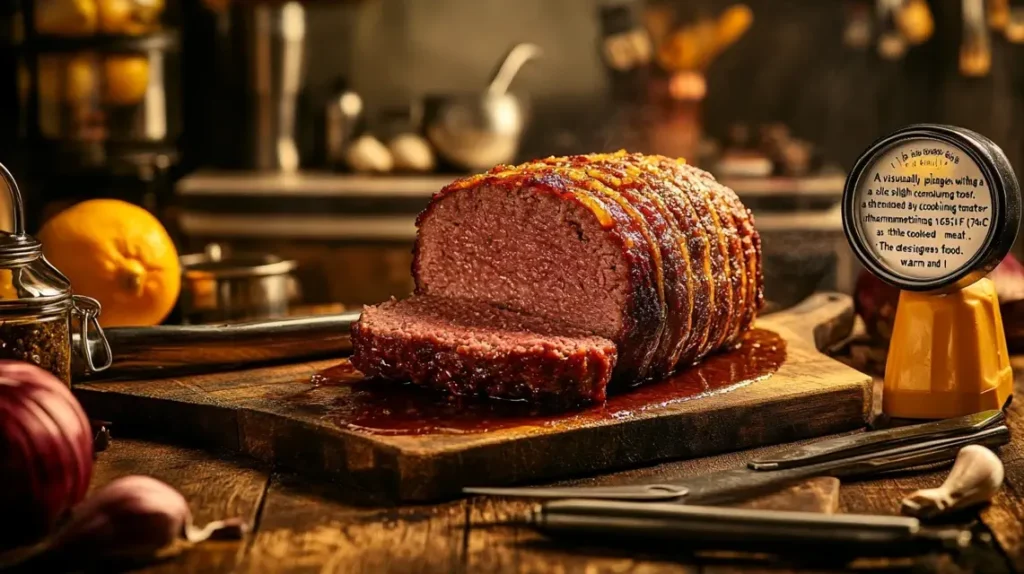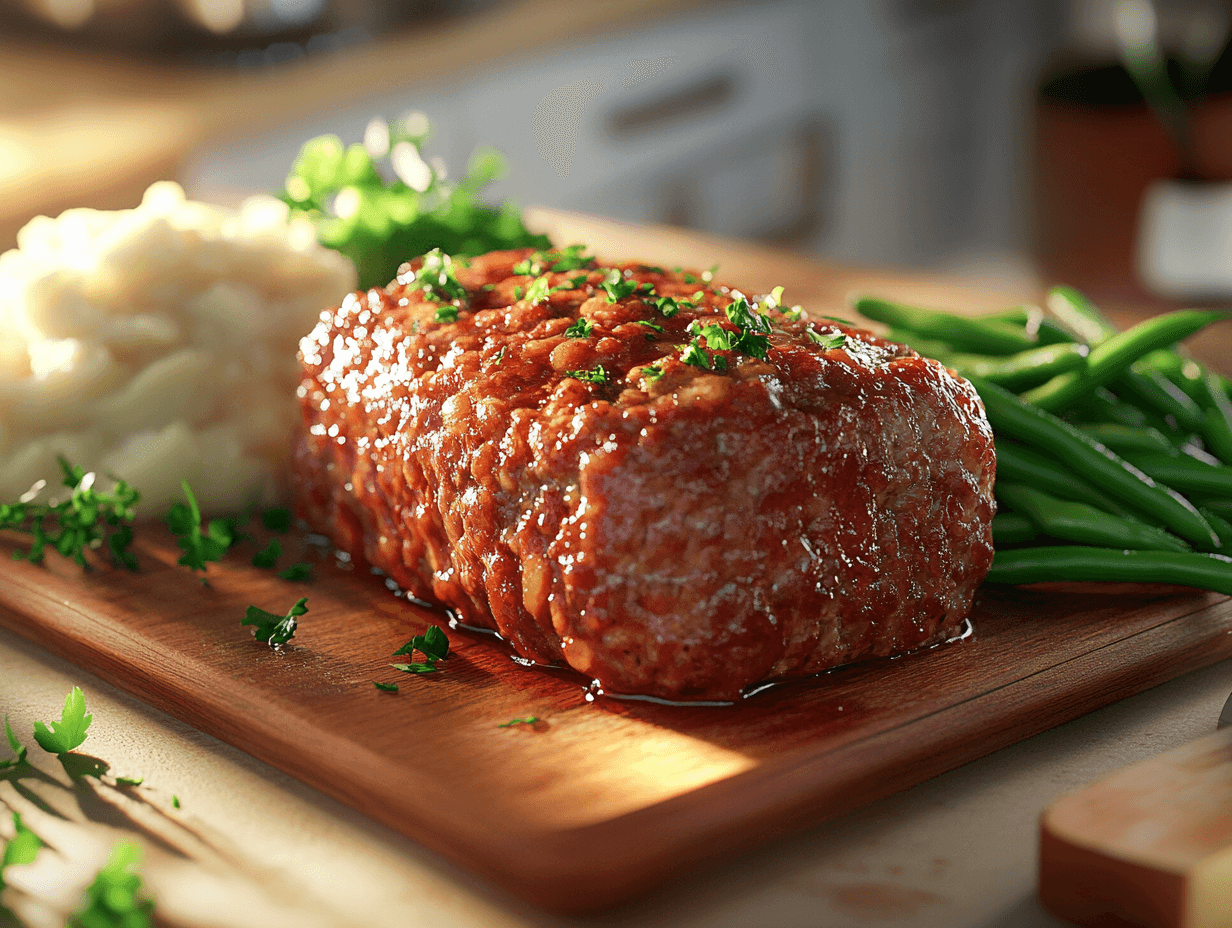Table of Contents
Meatloaf is a Comforting classic, but its color often leaves people Scratching their heads. You’ve probably cut into a perfectly baked loaf, only to see a slightly pink Interior. Does that mean it’s Undercooked? Is it safe to eat? These questions are common, and the answers are a mix of science, cooking techniques, and a little Culinary insight.
This article Explores the reasons why Meatloaf can stay pink, even when fully cooked, and how to ensure it’s safe to eat. From understanding the role of Nitrates to Mastering proper cooking methods, we’ll cover it all. By the end, you’ll know exactly when it’s okay to dig in and when you should be Cautious.
Understanding Meatloaf’s Pink Hue
Why Meatloaf Might Be Pink Even When Fully Cooked
When it comes to cooked meatloaf, the color of the interior doesn’t always tell the full story. The pink hue that many associate with undercooked meat can persist for several reasons, even when the meat has reached a safe internal temperature.
One culprit is the presence of nitrates and nitrites, which are naturally occurring compounds found in ingredients like onions, celery, and bell peppers. These compounds can interact with the meat’s proteins, locking in a pink color despite full cooking. Similarly, salt or cured meats used in some recipes may have the same effect.
Cooking at high temperatures doesn’t always solve the issue either. Certain ovens, especially older gas models, may produce small amounts of carbon monoxide, which binds to the hemoglobin in the meat and creates a pinkish hue. This phenomenon is more common than you might think!
Is Color a Reliable Indicator of Doneness?
Let’s bust a common myth: the color of your meatloaf isn’t a reliable way to determine if it’s safe to eat. According to the USDA, ground beef and meatloaf must reach an internal temperature of 160°F to be considered safe. Using a meat thermometer is the only surefire way to check doneness.
Interestingly, even when cooked to this temperature, meatloaf may remain pink. This happens because certain proteins in the beef retain their red color when exposed to heat. On the flip side, overcooked meatloaf can sometimes appear gray and unappetizing, even if it’s safe to eat.
By relying on a thermometer and understanding the science behind these color changes, you can enjoy meatloaf without unnecessary worry. After all, appearance can be deceiving—especially in the world of cooking!
Meatloaf Safety Guidelines
The Safe Cooking Temperature for Meatloaf
Cooking meatloaf to the correct temperature is essential for food safety. According to the USDA, the internal temperature of ground beef should reach at least 160°F. Using a food thermometer is not just recommended—it’s a must. This ensures that the meatloaf is safe to eat, regardless of whether it appears pink inside.
When asking, “Is it okay if meatloaf is a little pink?” the answer lies in the thermometer, not the eye. Even if your loaf retains some pink coloring, it doesn’t necessarily mean it’s undercooked. Internal temperature is the definitive factor for food safety, so never skip this step!
How to Check Meatloaf’s Doneness
Checking the temperature properly is as important as cooking itself. Insert a digital thermometer into the thickest part of the meatloaf. Ensure it’s not touching the pan or any fillers like cheese, which can give inaccurate readings. To be thorough, take readings from several spots.
If you find certain areas undercooked, these might be “cold spots” due to uneven oven heating. In this case, extend the cooking time or rotate the pan midway. A reliable thermometer paired with consistent heat will ensure every bite is safe and delicious.
Common Causes of Pink Meatloaf
Effects of Cooking Techniques on Color
Did you know that how you cook your meatloaf directly affects its appearance? Sometimes, uneven heat distribution in ovens can leave parts of the meatloaf looking pink. Gas ovens, in particular, can produce small amounts of carbon monoxide, which binds to proteins and maintains the pink hue.
Preheating your oven and rotating the pan midway through cooking can help solve this issue. Baking meatloaf in a loaf pan can also contribute to even cooking, as the enclosed shape distributes heat more uniformly.
Ingredient Interactions That Affect Color
The ingredients in your recipe might also explain why meatloaf sometimes stays pink. Vegetables like celery, onions, and bell peppers are naturally high in nitrates. When cooked with ground beef, these nitrates can react with the meat proteins, creating a persistent pink shade.
Salt and certain spices can have a similar effect. Additionally, processed meats or bacon added to recipes can introduce nitrites, another compound responsible for pink coloration. While these ingredients enhance flavor, they can also make it challenging to judge doneness visually.
For a deeper dive into how nitrates impact cooking, check out Cozzy Recipes’ guide on meatloaf safety, which also offers tasty variations.
Techniques to Minimize Pink Pockets
Tips for Uniform Cooking
A common frustration for home cooks is cutting into their meatloaf only to find pink pockets. While it’s tempting to chalk this up to undercooking, the issue often lies in uneven heating or preparation methods. To tackle this, start by preheating your oven thoroughly. This ensures the heat is evenly distributed from the beginning, creating a consistent cooking environment.
Rotating the pan midway through cooking can also help. If your oven has a hot spot, shifting the loaf allows for even exposure to heat. Baking meatloaf on a sheet pan instead of in a loaf pan may also improve airflow, reducing the risk of isolated pink areas. These simple tweaks make a big difference in achieving even cooking.
Ingredient Preparation for Consistency
How you handle your ingredients can also influence whether your meatloaf stays pink in places. Bringing ingredients to room temperature before mixing prevents uneven cooking, as cold pockets can lead to undercooked areas. It’s also crucial to mix the meat, binders, and seasonings thoroughly—but don’t overwork the meat, as this can make the texture dense.
If you’re incorporating vegetables like onions or bell peppers, dice them finely or sauté them first. This reduces the chances of raw spots that could interact with the meat proteins and cause pink discoloration. For more insights into ingredient prep, see Cozzy Recipes’ guide on comfort food casseroles, which provides helpful tips for hearty dishes like meatloaf.
Bonus Tips and Variations for Meatloaf Success
Creative Twists for Classic Meatloaf
Why stick to tradition when you can experiment? Adding different ingredients can bring exciting flavors to your meatloaf. Swap ground beef for ground turkey or chicken for a leaner option. Or, mix in Italian sausage for a spicy kick.
For a veggie-packed version, consider folding in finely grated zucchini or carrots. These not only add nutrients but also keep the meatloaf moist. Alternatively, topping your loaf with a tangy barbecue sauce or sweet chili glaze can transform the dish into something truly unique.
Troubleshooting Common Meatloaf Issues
Even with the best plans, things can go wrong. If your meatloaf turns out too dry, next time try adding more binder, like breadcrumbs or eggs, to retain moisture. If it’s crumbly, ensure the mixture is well-blended, but avoid overmixing to prevent toughness.
And if you’re still wondering, “Is it okay if meatloaf is a little pink?”, remember: as long as it’s cooked to 160°F, you’re good to go! Armed with these tips, you’re ready to create meatloaf that’s not just safe but also irresistibly delicious.
For more creative ideas and detailed recipes, visit Cozzy Recipes. Their guides cover everything from perfecting classics to crafting new favorites.
Serving Suggestions for Meatloaf
Classic Side Dishes to Pair with Meatloaf
Meatloaf is a hearty dish that shines best with comforting sides. Mashed potatoes, for example, complement its rich, savory flavor perfectly. Add a generous drizzle of gravy, and you’ve got a meal that feels like a warm hug. Steamed green beans or roasted carrots can add a pop of color and a touch of freshness to balance the meal.
If you’re looking for something more robust, consider serving your meatloaf with baked mac and cheese. The creamy, cheesy goodness is the perfect foil for the dense texture of the meatloaf. A crisp garden salad with a light vinaigrette can also provide a refreshing counterpoint.
Creative Side Options for a Twist
If you want to step outside the box, try pairing meatloaf with unconventional sides. Sweet potato fries or a tangy coleslaw can add new dimensions to this classic dish. Looking for more zest? Serve it alongside a Mexican-style street corn salad or a spicy rice pilaf.
For even more inspiration, check out Cozzy Recipes’ guide to creative sides. With these ideas, your meatloaf dinner will never feel ordinary again.
Storing and Reheating Meatloaf
How to Store Leftover Meatloaf
Storing leftover meatloaf is simple and ensures you can enjoy it for days. Once the meatloaf has cooled to room temperature, wrap it tightly in plastic wrap or aluminum foil. You can also place it in an airtight container to maintain freshness. Properly stored in the refrigerator, meatloaf stays good for up to four days.
If you want to keep it longer, freezing is an excellent option. Slice the meatloaf into individual portions, wrap each piece in foil or plastic wrap, and store them in a freezer-safe bag. This makes reheating easy and prevents waste.
Tips for Reheating Meatloaf
To reheat meatloaf, use the oven for the best results. Preheat your oven to 300°F, place the meatloaf slices in a covered dish to retain moisture, and heat for about 15–20 minutes. For a quicker option, use the microwave, but cover the meatloaf with a damp paper towel to keep it moist.
Avoid reheating meatloaf multiple times, as this can dry it out and compromise its quality. And don’t worry—if you’re still asking yourself, “Is it okay if meatloaf is a little pink?” the answer remains yes, as long as it was cooked to the correct internal temperature the first time.
For more tips on preserving leftovers, visit Cozzy Recipes and explore their expert storage guides.
FAQs About Pink Meatloaf
Is It Okay if Meatloaf Is a Little Pink at 160°F?
Absolutely! When meatloaf reaches the safe internal temperature of 160°F, it’s fully cooked, even if it appears pink. The persistent pink hue is often due to factors like nitrates or certain cooking methods. Trust your thermometer, not your eyes, to determine doneness.
Can Certain Recipes Cause Meatloaf to Stay Pink?
Yes, recipes that include nitrate-rich ingredients—like onions, celery, or processed meats—can contribute to the pink color. High salt levels or certain curing agents may also play a role. If you’re unsure, sticking to a basic recipe can help minimize this effect.
How Can I Prevent Uneven Cooking in Meatloaf?
To avoid uneven cooking, always preheat your oven, rotate the pan, and test the temperature in multiple spots. Properly mixing your ingredients and ensuring they’re at room temperature will also help achieve uniform results.
Should I Discard Meatloaf That Looks Under-Cooked?
If the internal temperature hasn’t reached 160°F, it’s best to cook it longer. However, if your thermometer confirms the meatloaf is fully cooked, the pinkness is likely harmless. In such cases, there’s no need to throw it away.
For more delicious meat recipes, check out Cozzy Recipes’ collection of chicken and beef dishes.
Conclusion: Is It Okay if Meatloaf Is a Little Pink?

Cooking meatloaf can be a mix of art and science, leaving many home cooks wondering, “Is it okay if meatloaf is a little pink?” The answer lies in understanding the factors behind its appearance and relying on temperature, not color, to gauge doneness.
When meatloaf reaches an internal temperature of 160°F, it’s safe to eat, even if there are slight pink areas. The pinkness often results from nitrates in vegetables or seasonings and doesn’t indicate undercooking. By following proper cooking methods—like preheating the oven, rotating the pan, and mixing ingredients evenly—you can minimize pink spots while ensuring your loaf is cooked to perfection.
Ultimately, a meat thermometer is your best tool for achieving both safety and peace of mind. Don’t let visual cues lead you astray! Armed with the right techniques and knowledge, you can enjoy this comforting classic without second-guessing its doneness.
For more tips on creating delicious dishes, explore Cozzy Recipes’ guide to hearty meals. From meatloaf to casseroles, there’s something for every occasion!

